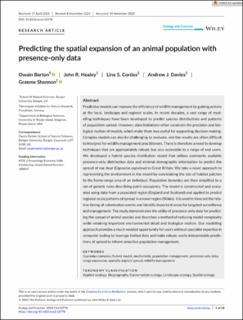| dc.contributor.author | Barton, Owain | |
| dc.contributor.author | Healey, John R. | |
| dc.contributor.author | Cordes, Line | |
| dc.contributor.author | Davies, Andrew J. | |
| dc.contributor.author | Shannon, Graeme | |
| dc.coverage.spatial | Great Britain, England, Scotland, Wales | en_US |
| dc.date.accessioned | 2023-12-15T09:40:40Z | |
| dc.date.available | 2023-12-15T09:40:40Z | |
| dc.date.created | 2023-11-28T08:59:14Z | |
| dc.date.issued | 2023 | |
| dc.identifier.issn | 2045-7758 | |
| dc.identifier.uri | https://hdl.handle.net/11250/3107721 | |
| dc.description.abstract | Predictive models can improve the efficiency of wildlife management by guiding actions at the local, landscape and regional scales. In recent decades, a vast range of modelling techniques have been developed to predict species distributions and patterns of population spread. However, data limitations often constrain the precision and biological realism of models, which make them less useful for supporting decision-making. Complex models can also be challenging to evaluate, and the results are often difficult to interpret for wildlife management practitioners. There is therefore a need to develop techniques that are appropriately robust, but also accessible to a range of end users. We developed a hybrid species distribution model that utilises commonly available presence-only distribution data and minimal demographic information to predict the spread of roe deer (Capreolus caprelous) in Great Britain. We take a novel approach to representing the environment in the model by constraining the size of habitat patches to the home-range area of an individual. Population dynamics are then simplified to a set of generic rules describing patch occupancy. The model is constructed and evaluated using data from a populated region (England and Scotland) and applied to predict regional-scale patterns of spread in a novel region (Wales). It is used to forecast the relative timing of colonisation events and identify important areas for targeted surveillance and management. The study demonstrates the utility of presence-only data for predicting the spread of animal species and describes a method of reducing model complexity while retaining important environmental detail and biological realism. Our modelling approach provides a much-needed opportunity for users without specialist expertise in computer coding to leverage limited data and make robust, easily interpretable predictions of spread to inform proactive population management. Capreolus capreolus, hybrid model, mechanistic, population management, presence-only data, range expansion, spatially explicit spread, wildlife management Applied ecology, Biogeography, Conservation ecology, Landscape ecology, Spatial ecology | en_US |
| dc.language.iso | eng | en_US |
| dc.rights | Navngivelse 4.0 Internasjonal | * |
| dc.rights.uri | http://creativecommons.org/licenses/by/4.0/deed.no | * |
| dc.subject | Capreolus capreolus | en_US |
| dc.subject | hybrid model | en_US |
| dc.subject | mechanistic | en_US |
| dc.subject | population management | en_US |
| dc.subject | presence-only data | en_US |
| dc.subject | range expansion | en_US |
| dc.subject | spatially explicit spread | en_US |
| dc.subject | wildlife management | en_US |
| dc.subject | Applied ecology | en_US |
| dc.subject | Biogeography | en_US |
| dc.subject | Conservation ecology | en_US |
| dc.subject | Landscape ecology | en_US |
| dc.subject | Spatial ecology | en_US |
| dc.title | Predicting the spatial expansion of an animal population with presence-only data | en_US |
| dc.title.alternative | Predicting the spatial expansion of an animal population with presence-only data | en_US |
| dc.type | Peer reviewed | en_US |
| dc.type | Journal article | en_US |
| dc.description.version | publishedVersion | en_US |
| dc.rights.holder | © 2023 The Authors | en_US |
| dc.subject.nsi | VDP::Zoologiske og botaniske fag: 480 | en_US |
| dc.subject.nsi | VDP::Zoology and botany: 480 | en_US |
| dc.source.volume | 13 | en_US |
| dc.source.journal | Ecology and Evolution | en_US |
| dc.source.issue | 11 | en_US |
| dc.identifier.doi | 10.1002/ece3.10778 | |
| dc.identifier.cristin | 2203413 | |
| dc.relation.project | Andre: KESS 2 Knowledge Economy Skills Scholarship, c80815 | en_US |
| cristin.ispublished | true | |
| cristin.fulltext | original | |
| cristin.qualitycode | 1 | |

